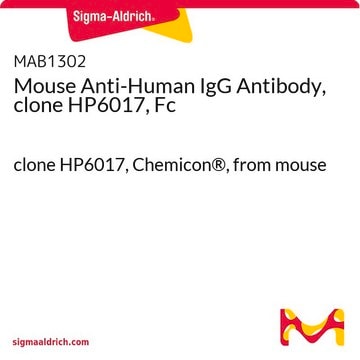SAB4200788
Anti-Human IgG1 (Fc specific) antibody, Mouse monoclonal
clone HP-6001, purified from hybridoma cell culture
Sinônimo(s):
Anti-Human immunoglobulin G1
Selecione um tamanho
Selecione um tamanho
About This Item
Produtos recomendados
fonte biológica
mouse
Nível de qualidade
forma do anticorpo
purified from hybridoma cell culture
tipo de produto de anticorpo
primary antibodies
clone
HP-6001, monoclonal
Formulário
buffered aqueous solution
reatividade de espécies
human
concentração
~1.0 mg/mL
técnica(s)
indirect ELISA: 0.5 μg/mL using 1 μg/mL Human IgG1 myeloma protein for coating.
Isotipo
IgG2b
Condições de expedição
dry ice
temperatura de armazenamento
−20°C
modificação pós-traducional do alvo
unmodified
Descrição geral
The amount of the different IgG subclasses present in the bloodstream varies with age. For example, IgG1 and IgG3 reach normal adult levels by 5-7 years of age while IgG2 and IgG4 levels raise more slowly, reaching adult levels at about 10 years of age. Serum IgG subclass deficiencies have been recorded for different patient groups. For example, a disproportionate elevation of IgG1 has been found in the cerebral spinal fluid of patients with multiple sclerosis.Examination of the distribution pattern of IgG subclasses in different types of diseases may provide insight into the immunological processes involved and may assist in the diagnosis of various disorders.
Monoclonal Anti-Human IgG1 (Fc specific) specifically recognizes Fc region of Human IgG1. The antibody shows no cross-reactivity with human IgG2, IgG3 and IgG4. This clone has been established as a useful human IgG1 specificity standard by the WHO/IUIS.
Imunogênio
Aplicação
forma física
Outras notas
Não está encontrando o produto certo?
Experimente o nosso Ferramenta de seleção de produtos.
Código de classe de armazenamento
12 - Non Combustible Liquids
Classe de risco de água (WGK)
nwg
Ponto de fulgor (°F)
Not applicable
Ponto de fulgor (°C)
Not applicable
Escolha uma das versões mais recentes:
Certificados de análise (COA)
Não está vendo a versão correta?
Se precisar de uma versão específica, você pode procurar um certificado específico pelo número do lote ou da remessa.
Já possui este produto?
Encontre a documentação dos produtos que você adquiriu recentemente na biblioteca de documentos.
Os clientes também visualizaram
Active Filters
Nossa equipe de cientistas tem experiência em todas as áreas de pesquisa, incluindo Life Sciences, ciência de materiais, síntese química, cromatografia, química analítica e muitas outras.
Entre em contato com a assistência técnica

















